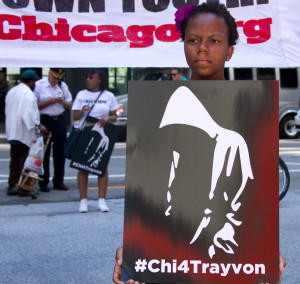
- Photo by Jennifer Lacey / The Chicago Bureau
(UPDATED with clarifications and more information)
From The Chicago Bureau
Following mass demonstrations in Miami, New York and cities nationwide, thousands took to the streets of Chicago over the weekend to protest the George Zimmerman not-guilty verdict and demand justice for slain 17-year-old Trayvon Martin. And the volume hasn’t quieted.
Martin was shot in February 2012 after Zimmerman, a neighborhood watch volunteer, followed him as he walked through a gated community and a fight broke out between the two. Martin was unarmed, though Zimmerman later reported having been thoroughly beaten by the teenager.
The protests still come more than a week after six jurors, all women, acquitted Zimmerman, agreed with the Zimmerman self-defense claim. It has been noted that Zimmerman, who is biracial but identified as Hispanic, did not invoke the 'Stand Your Ground' law despite it becoming a rallying cry across the country for opponents of the jury's decision.
Meanwhile, President Barack Obama remorsefully speculated that, “You know, when Trayvon Martin was first shot, I said that this could have been my son. Another way of saying that is Trayvon Martin could have been me, 35 years ago.”
It was a statement that lent fresh fuel to national debate on the state of race relations.

A girl holds poster demanding ‘justice’ for Trayvon Martin, 17, who was slain at the hand of George Zimmerman, who was cleared last week of all charges/Photo by Jennifer Lacey
As U.S. Attorney General Eric Holder calls for review of ‘Stand Your Ground,’ local activists expressed frustration with what they view as stagnating progress in American civil rights. Reverend Jesse Jackson encouraged Chicagoans to adopt changing Florida’s gun laws as a personal crusade. On the flip side, others argued that the prosecution simply put on a bad case. In interviews by the Bureau following the verdict, many who agreed with the verdict did so on legal grounds, saying race should not play a part in the jury’s decision. At least one juror has gone public to say that race did not, in fact, play a role in the deliberations; the defense simply had the stronger case.
Nevertheless, the fallout has been echoing since. “We must all boycott Florida and stop Stand Your Ground,” Jackson said in an interview with WGN. “No more concerts. No more conventions. No more spring breaks. We must stand our ground until Florida’s law is abolished.”
The call to boycott Florida was equaled with jeers at a justice system that is, with the incarceration rate exploding more than 600 percent over a generation, heavily skewed against people of color. It has also raised the notion of ‘white privilege,’ in which some scholars argue that most issues are seen through the lens of whites. And so, for example, our vision of a ‘criminal’ may be one race or ethnicity when the numbers overwhelming argue that with the high arrest rates for whites and the sheer number of whites in this country that the vision of a perpetrator should be of a white person.
 Graphic by Matt Blake
Graphic by Matt Blake
Whatever the case, the question of race, and whether it played a role in the case has never been shaken in this country. It has experienced waves of greater acceptance and mainstreaming of people of color – chiefly blacks and Latinos or Hispanics – but that has almost without fail been followed by times of great tension made most clear in high-profile cases of violence such as the Zimmerman trial for Martin’s death.
At the same time, states are grappling with a national map that shows all states, with the exception of the District of Columbia, have enacted some form of conceal-carry laws, forcing municipalities, including Chicago and Evanston, to reflect on the Martin case and ask whether having a greater number of people armed could lead to more cases similar to the drama that has played out in Florida and framed the national discussion for so long.
Gun rights activists dismiss this claim and argue that arming more people would actually reduce violence by equaling the field between would-be perpetrator and would-be victim. Both sides of the gun debate have seized on the case, in fact, to talk about other issues – including assault weapons bans that became such a focus after the Sandy Hook Elementary School massacre.
In Chicago, the law is clear. No guns allowed. Yet violence is epidemic in this city, according to stats that show it to be tops in the country in shootings and murders. Still, others reacted differently. In the northern Chicago suburb of Lake Forest, officials decided not to follow the lead of many villages and towns surrounding in enacting an assault weapons ban passed in the state by the deadline. Instead they let it pass, saying the issue was tricky and would leave open the village to legal liabilities.
 Graphic by Matt Blake
Graphic by Matt Blake